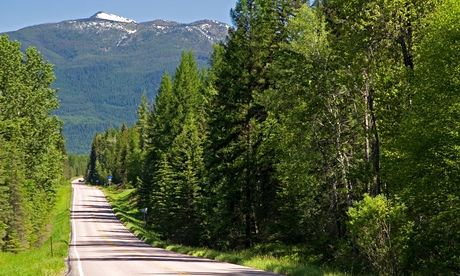
Dreams come true on Broadway, people get their kicks on Route 66, but what, you might be forgiven for wondering, has ever happened on Route 83? What indeed.
Reynolds’s grandfather, a British accountant who turned to drink, ended up in the middle of Canada, somewhere high above Winnipeg, working as a cobbler. That story became the subject of Reynolds’s first book, Swan River. Swan river also provides the opener for this book, for the small Canadian town sits at the head of Route 83, a highway that cuts through the heart of the United States. “Goes from here to Brownsville, Texas,” Reynolds is told, “right down there in the south, as far as you can go in the USA. Drive across a bridge and you’re in Mexico.” That single, simple thought is enough to set him off on a great big American road trip. But is it enough for us to follow him?
The 83 runs 2,271 miles south from Swan river. The country it crosses is not glamorous, not the jazz route to New Orleans or the Pacific Coast route to San Francisco. Looking at the map of the Dakotas, Nebraska, Kansas, Oklahoma and Texas, the only place names that resonate – Dodge City, San Antonio, Rio Grande – played a part in the creation of the US, in the Mexican wars and the long, painful fight against the Native American tribes.
This is a slow-starter of a narrative, coloured as much by the character of an author who admits to suffering “from what is sometimes called an English reserve” as by the slow nature of the road. It isn’t until some 30 pages in, for instance, that we learn he is travelling in June. Passing deer beside a road in Manitoba, he realises he has never before travelled like this, with nothing to hurry for, able to take his time (unsurprising when you realise that he was one of the four founders of Bloomsbury Publishing). In many ways, therefore, he is the perfect man for the route, a retiring Englishman on a forgotten highway, driving not some Hunter S Thompson-inspired, shark-finned gas-guzzler but a modest hybrid car, heading not for Las Vegas but the Great Plains, where the old ways of farming are giving way to a fracking gold rush.
Reynolds cites the Native Americans as one of the main reasons for his journey along Route 83. As a child he watched westerns, read comics and played cowboys and Indians, but had become aware that the view he had been fed was skewed. The Sioux, Cheyenne, Apache and other tribes “were on my mind when I planned this trip”. So this is as much about understanding their story as it is about glorifying the American love of the road. To do either, one needs to know the texts of Kerouac, Capote and others, which Reynolds certainly does. One also needs to take time along the way. Yet after more than 370 pages, after many drinks, meals and encounters in hotels, motels, diners and bars, the narrative feels curiously rushed. As he heads south and the weather warms, he loses some of his English reserve and talks to more people, but the book would have benefited from fewer brief encounters and more moments like the one he has with a Texan restaurateur, Carol Taylor, who takes him to her ranch to explain how she runs it along the lines of what amounts to caring capitalism.
Perhaps that is expecting too much of a road trip that delivers the author to the Mexican border a wiser man, having learned that Buffalo Bill was not a hero, that Native Americans were capable of fighting and torturing other tribes, that Hispanics taught American settlers how to ride horses and herd cattle, just as Native Americans taught them how to farm. There might be kicks on Route 66, but there is gentle enlightenment along 83.
• Slow Road to Brownsville is published by Greystone Books (£10.99). Click here to buy it for £8.79

